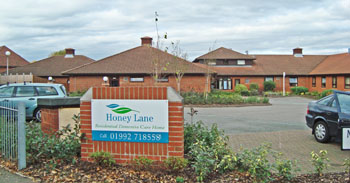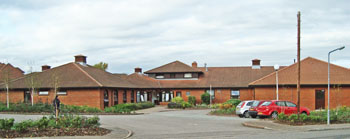Infectious diseases. Later, TB, chest diseases, medical, neurological and oral surgery. Later, geriatric
In 1905 the Waltham Joint Hospital Board approved the erection of an isolation hospital to serve the districts of Buckhurst Hill, Chingford and Waltham Cross.
The Waltham Abbey Isolation Hospital (also known as the Waltham Joint Hospital for Infectious Diseases) took three years to build and was officially opened by Lady Gwendoline Colvin in December 1908.
The Hospital, which had cost £7,100, consisted of an entrance lodge, an administrative building and 24 beds in three ward blocks. Another building housed the laundry and disinfecting station, as well as the mortuary, coal store and ambulance shed. Four acres of the 10-acre site were given over to agricultural use and sewage disposal (there was no access to the mains and effluent sewage was treated using septic tanks and a bacteria bed with revolving sprinklers).
The pavilion ward blocks were built of red brick and roofed with Brosely tiles (these were strawberry-coloured tiles of the highest quality). The blocks were grouped around a small lawn behind the administration building and lay within 40 feet (12 metres) of each other. A small isolation block had 4 beds in two wards, with a nurses' Duty Room between; it was entered from a verandah to prevent contagion. The block for diphtheria patients had male and female wards of 4 beds each, and a bathroom and a nurses' Duty Room. The scarlet fever block was similar in design, with male and female wards of 6 beds each and a convalescent room on the upper floor. The wards had no skirting boards and all corners to the rooms were rounded, so as not to harbour dust and dirt. The floors were of polished pine, except in the bathrooms and passages, which were tiled.
In 1908 the Board was enlarged to include Woodford Urban District. The administration building was extended and a new ward block with 16 beds was erected.
During WW1 some 32 beds were reserved for wounded and sick servicemen.
In 1932 a public enquiry was conducted by two inspectors from the Ministry of Health into conditions at the Hospital following the deaths of two patients. Complaints had been received concerning the general administration of the Hospital.
By 1933 the Board included the Chigwell Urban District and, in 1934, Wanstead. The Hospital then served these areas as well as Loughton, and the Epping Urban and the Epping Rural Districts.
In the mid 1930s more land was purchased and the Hospital was enlarged. The number of beds increased to 130, with the possibility of further expansion, if need be, to 250 beds.
A new ward pavilion with 28 beds had been built for diphtheria cases and a similar one for scarlet fever patients; both had separation wards. The new wards had teak floors. Each ward had an individual colour scheme, with terrazzo dados in a contrasting coloured band along the walls. Other new buildings included a 26-bedded ward pavilion with verandahs and rooms for convalescents, a 12-bedded cubicle block with an operating theatre, and a 2-storey Nurses' Home for 40 nurses. The buildings were heated and supplied with hot water by a centralised system from the new boiler house, which also supplied steam to the laundry, kitchen, sterilisers and disinfectors. A new laundry had also been built, as well as a mortuary and post-mortem room, an engineers' office, a garage and a water tower.
Three of the four original ward blocks were renovated and upgraded, while the isolation block was converted into a lecture hall. The old laundry was incorporated into the extended administrative building.
During WW2 the Hospital joined the Emergency Medical Service with 130 beds.
The Joint Hospital Board ceased to exist when the NHS was introduced in 1948. The Hospital then came under the control of the Epping Group Hospital Management Committee, part of the North East Metropolitan Regional Hospital Board. It was the second largest in the Group after St Margaret's Hospital in Epping.
One of the empty wards was adapted temporarily as a chest clinic when the Chest Clinic at Waltham Cross transferred to the Hospital in 1949.
In 1950 it was regarded as a well-equipped modern hospital, but only 40 of its 120 beds were staffed. Immunisation had made diphtheria rare, so there was no need to set aside a ward for these cases. Instead, 52 beds in two ward blocks were designated for female TB patients (although staff shortages resulted in admissions being restricted from time to time). An X-ray Department had been established in 1948 in a section of one of the smaller wards, but the machine was secondhand and the service was limited. It did, however, enable TB patients to be X-rayed on site rather than at St Margaret's Hospital, and also frequent check-ups could be made on the health of the staff. A Pathology Department was also set up in part of one of the smaller wards and, as well as its own work, it received specimens from Waltham Abbey War Memorial Hospital.
The Epping Group Hospital Management Committee planned to develop the laundry so that all the laundry work for the Group could be done on the site, but financial restrictions delayed this project. However, laundry was sent over from the neighbouring Waltham Abbey War Memorial Hospital.
By 1951 three ward blocks (78 of the 120 beds) had been designated for TB patients, but the lack of staff meant that only one ward of 26 beds could be kept open permanently. A second ward opened for varying periods when staff became available. Moreover, the Hospital lacked facilities for infectious diseases patients, with only 12 beds in the Cubicle Block available.
In 1952 it was renamed Honey Lane Hospital. In July 1952 Ward Block 6 with 26 beds opened for general medical cases (admitted from the Out-Patients Department at St Margaret's Hospital). Ward Blocks 4 and 5, with a total of 56 beds, were for TB patients; one for males and one for females. Of the Hospital's 118 beds, only 14 were for infectious diseases. The Management Committee decided to convert one of the unused ward blocks - Ward Block 3 - into cubicles for these patients.
The old X-ray apparatus was replaced, while the former Ward Block 2 became the Pathology Department, dispensary, Chest Clinic, Occupational Therapy Department and a library for the patients.
The League of Friends was formed in 1952, and the Waltham Abbey Amateur Theatrical Society presented the gift of a TV set to the Hospital for the use of its in-patients.
By 1953 some 96 of the 118 beds were open. Plans were made to adapt another of the unused wards into an Out-Patients Department.
In 1955 the Hospital had 116 beds. Ward Block 3, converted into 20 separate cubicles, had opened in April 1955. The Hospital then had 34 beds in two ward blocks for infectious diseases patients. It treated 118 cases of polio during the epidemic that occurred in the 1950s. With the two TB wards and the general medical ward in Block 6, all the wards were finally in use.
With the introduction of new drug therapies the incidence of pulmonary TB had been falling, and the female TB patients at St Margaret's Hospital were transferred to Honey Lane when their ward closed.
In August 1957 six of the 26 general medical beds were designated for neurological patients.
By the end of the 1950s a Physiotherapy Department had been established for recovering polio patients, and a playroom provided for convalescents. A second respirator - the "Beaver" Positive Pressure Respirator - was purchased for Block 3. The X-ray Department had been further developed and a new mobile X-ray unit bought. The kitchen equipment had been improved. The verandah at the rear of the male TB ward (Block 4) was covered with tarmac (that for the female ward in Block 5 had been done previously), and sun blinds were installed. The League of Friends provided a mobile telephone trolley for the TB wards, as well as two large-screen TV sets.
A Regional Maxillofacial Unit with in-patient beds was established in the early 1960s; it was staffed by the London Hospital.
In 1963, when the Hospital had 112 beds for TB, oral surgery and general medical cases, it came under the auspices of the Harlow Group Hospital Management Committee, which managed the newly opened Princess Alexandra Hospital in Harlow.
In 1974, following a major reorganisation of the NHS, administration of the Hospital transferred to the Harlow District Health Authority, part of the Essex Area Health Authority. It had 106 beds for diseases of the chest, oral surgery, medical and neurological cases.
In 1980 one of the wards was upgraded for use by geriatric patients. In 1982 the Hospital had 73 beds for mainly long stay patients and GP cases.
By 1985 it was under consideration of closure by the West Essex Health Authority, which had superseded the Harlow District Health Authority in 1982.
The Hospital closed in 1986.
Present status (October 2009)
The site was sold for £20m. The Hospital buildings were demolished and new houses and roads built. However, the main part of the site contains a large, low-rise unit, the Honey Lane Residential Dementia Care Home, owned by Carebase.

The Honey Lane Residential Dementia Care Home
(above and below).

http://hansard.millbanksystems.com (1980)
http://hansard.millbanksystems.com (1985)
http://hansard.millbanksystems.com (1986)
http://hansard.millbanksystems.com (1990)
www.british-history.ac.uk
www.efdhistory.org.uk
www.flickr.com
www.nationalarchives.gov.uk
Return to home page